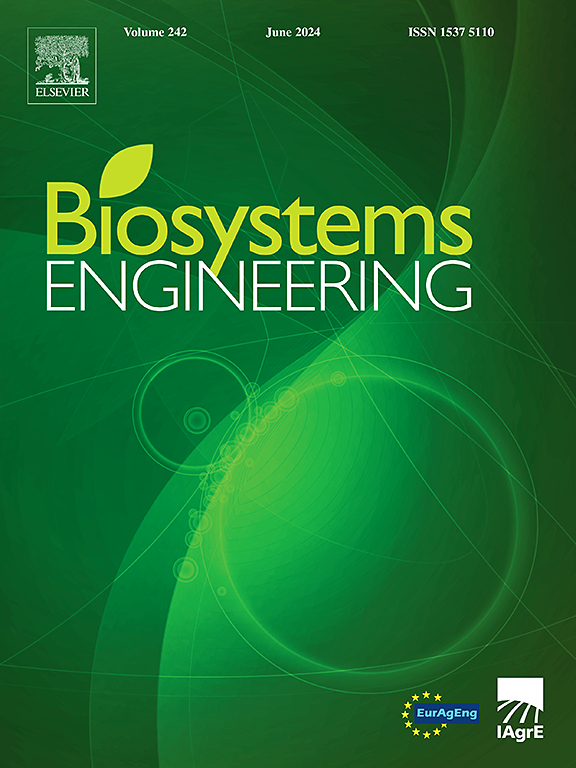Mechanism of low damage rate maize ear pre-threshing based on cob internal expansion cracking
IF 5.3
1区 农林科学
Q1 AGRICULTURAL ENGINEERING
引用次数: 0
Abstract
During mechanical threshing of maize, the connection forces between the kernels and the cobs, along with the mutual support forces among the kernels, are crucial factors determining the applied force by the threshing elements, impacting the extent of kernel damage. Currently, solutions aimed at reducing or eliminating the mutual support forces among kernels to minimise threshing damage have not been found. Thus, this study proposes a novel pre-threshing method involving the cob's internal expansion to split the maize ears into fragments to achieve partial threshing and diminish the mutual support forces among the kernels. A detailed analysis is conducted on the impact of kernel arrangement, position, and support quantity on both intact maize ears and maize ear fragments concerning stripping forces. Furthermore, based on the comprehensive force analysis on the process of fragmenting the maize ear from the internal, we have designed and fabricated a new test device. Experiments were performed on comparing three types of maize ears through 4-, 6-, and 8-bulging wedges on the expanding rod, respectively. Results indicated that the number of maize ear fragments ranged from 13 to 18 for TK 601 maize ears. As the number of wedge elements increased, fragment size decreased, with the average number of kernels per fragment reducing from 38 to 15. The proportion of individually detached kernels increased from 18.16 % to 55.89 %, while the kernel damage rate had a slightly increase from 0.08 % to 0.96 %. Similar trends were observed in the other two types of maize ears. This study provides a new solution for achieving low-damage threshing of maize.

基于玉米芯内膨胀开裂的低损失率玉米穗预脱粒机理
玉米机械脱粒过程中,籽粒与穗轴之间的连接力以及籽粒之间的相互支撑力是决定脱粒元件施加力大小的关键因素,影响着籽粒的损伤程度。目前,还没有找到旨在减少或消除籽粒之间相互支持力以尽量减少脱粒损害的解决方案。因此,本研究提出了一种新的预脱粒方法,通过玉米芯内部膨胀,将玉米穗分裂成碎片,实现部分脱粒,减少籽粒之间的相互支撑力。详细分析了籽粒排列、位置和支撑量对完整玉米穗和玉米碎穗剥离力的影响。在对玉米穗从内部破碎过程进行综合受力分析的基础上,设计并制作了一种新的试验装置。在膨胀杆上分别通过4、6、8个凸楔对3种玉米穗进行了比较试验。结果表明,tk601玉米穗片段数为13 ~ 18个。随着楔形元数量的增加,片段大小减小,每个片段的平均核数从38个减少到15个。籽粒分离率由18.16%增加到55.89%,籽粒损伤率由0.08%增加到0.96%。在其他两种类型的玉米穗上也观察到类似的趋势。本研究为实现玉米低害脱粒提供了新的解决方案。
本文章由计算机程序翻译,如有差异,请以英文原文为准。
求助全文
约1分钟内获得全文
求助全文
来源期刊

Biosystems Engineering
农林科学-农业工程
CiteScore
10.60
自引率
7.80%
发文量
239
审稿时长
53 days
期刊介绍:
Biosystems Engineering publishes research in engineering and the physical sciences that represent advances in understanding or modelling of the performance of biological systems for sustainable developments in land use and the environment, agriculture and amenity, bioproduction processes and the food chain. The subject matter of the journal reflects the wide range and interdisciplinary nature of research in engineering for biological systems.
 求助内容:
求助内容: 应助结果提醒方式:
应助结果提醒方式:


